By definition, abnormal pore pressure is any geo-pressure different from the established trend for the given area and depth. This article will introduce the six significant causes of abnormal pressure while drilling. Also, in the following articles, we will discuss its prediction and more.
Pressure may be
- less than usual, called subnormal, or
- greater than average, termed geo-pressured, super-pressured, or abnormal pressure.
Subnormal pressures present few direct well-control problems. However, subnormal pressures do cause many drilling and well-planning problems. For clarity, abnormal pore pressure will identify more significant pressures than usual.
What Is The Formation Pressure
Formation pressure is the fluids’ presence in the rock matrix’s pore spaces. These fluids are typically oil, gas, or salt water. The overburden stress is created by the weight of the overlying rock matrix and the fluid-filled pores. The rock matrix stress is the overburden stress less the formation pressure.
For general calculations, the overburden stress gradient is often assumed to be 1.0 psi/ft with a density of 19.23 lb/gal, an average weight of the fluid-filled plastic rock.
What Is The Normal Formation Pressure
Normal formation pressure equals the hydrostatic pressure of the native formation fluids. In most cases, the fluids vary from fresh water with a density of 8.33 Ib/gal'(0.433 psi/ft) to salt water with a 9.0 lb/gal (0.465 psi/ft). However, some field reports indicate instances when the normal formation fluid density was more significant than 9.0 lb/gal. Regardless of the fluid density, the average pressure formation can be considered an open hydraulic system where pressure can easily be communicated.
The Relation Between Entrapment & Abnormal Pressure
Abnormal formations do not have the freedom of pressure communications. If they did, the high pressures would rapidly dissipate and revert to normal pressures. Therefore, a pressure entrapment mechanism must be present before abnormal pore pressures can be generated and maintained. Fertl and Timko listed several of the more common entrapment seals worldwide (Table 1).
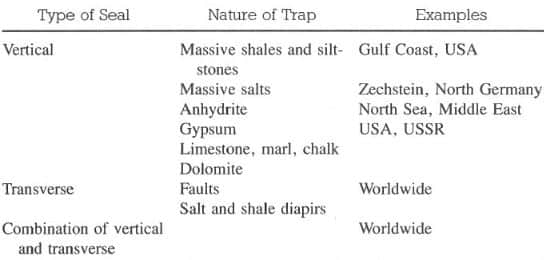
Assuming that a pressure seal is present, the causes or origins of pressure depend on such items as lithology, mineralogy, tectonic action, and sedimentation rate. Fertl lists many of the field-reported causes of high pressures (Table 2). Several of these causes will be discussed later.
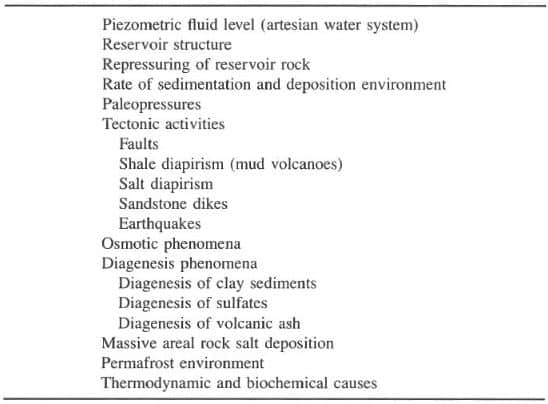
Compaction of Sediments.
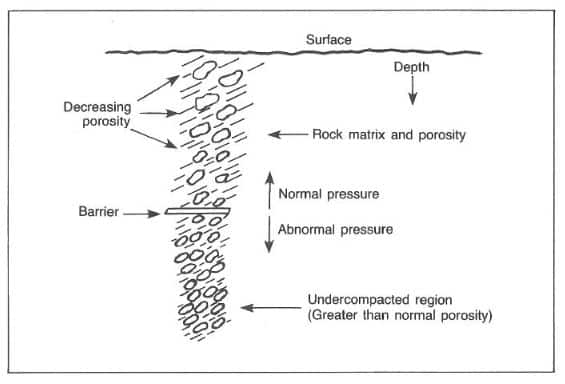
The normal sedimentation process involves the deposition of layers of various rock particles. As these layers continue to build depth and increase the overburden (total rock) pressure, the underlying sediments are forced downward under the weight of surface deposition. The overburden pressure in this case, is defined as the total of the rock matrix pressure and the formation fluid pressure. Under normal drilling conditions, the formation fluid pressure is the primary concern due to its ability to cause fluid flow into the wellbore under certain geological conditions and the general inability of the rock matrix to move into the wellbore because of its semi-rigid structure.
How the rock matrix accepts the increasing overburden load explains the abnormal pore pressures generated in this environment. The underlying rock must accept the load as the surface deposition and the resultant total overburden increase.
Rock matrix strength can increase with increased grain-to-grain contact of the individual rock particles. This implies that the resultant porosity must decrease with depth under normal sedimentary conditions. This relationship can be seen in Figs. 3 and 4. If the normal porosity compaction process is prohibited by not letting the fluids in the pore spaces escape, the rock matrix cannot increase its grain-to-grain contact or its overburden support capabilities.
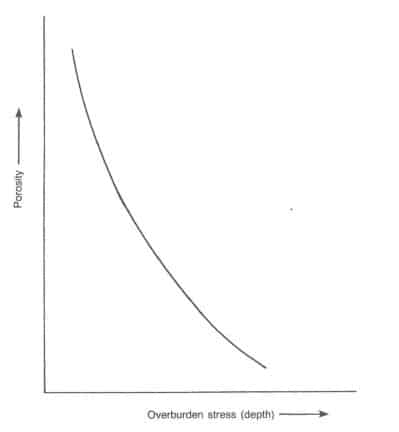
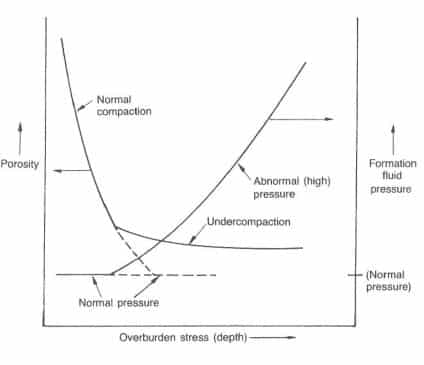
Since the total overburden load continues to increase with sedimentation and the rock matrix can no longer carry its burden, the fluids in the pores of the rock must begin to support part of the overburden, resulting in higher-than-normal fluid pressures (Fig. 4). The depth at which the abnormally high porosities are encountered is usually assumed to be the initial depth at which abnormal pore pressures are encountered.
The Sealing Mechanism
A sealing mechanism must be present to trap the abnormal pressures in their environment. The most common sealing mechanism in continuous depositional basins is a low-permeability layer of rock, such as a clean shale section. The shale reduces normal fluid escape, causing under-compaction and abnormal fluid pressures.
Calculation Of Formations Pressure
After we understand how sediment compaction Causes Abnormal Pressure While Drilling, we must know that Formation pressures resulting from under-compaction often can be approximated with some simple calculations. If it is assumed that compaction does not occur below the barrier depth, the formation fluid below the barrier must support all overburden, rock matrix, and formation fluids. The pressure can be calculated with Eq. 3.1:
EQ.1 : P = 0.465 psi/ft DB + 1.0 psi/ft (Dl – DB)
Where:
Dl = depth of interest below the barrier, ft
DB = depth of the barrier, i.e., low-permeability section, ft
P = formation pressure at Dl psi
In Eq. 1, the overburden pressure gradient is assumed to be 1.0 psi/ft, and the average formation fluid pressure gradient is 0.465 psi/ft.
Eq. 1 can be used to approximate formation pressures. However, formations typically have some degree of compaction below the barrier. As a result, Eq. 1 can’t be expected to provide precise results in most cases. If necessary, a more complex series of calculations based on Eq. 1 can be used to increase the method’s accuracy. This complex procedure will not be presented.
Artesian Systems.
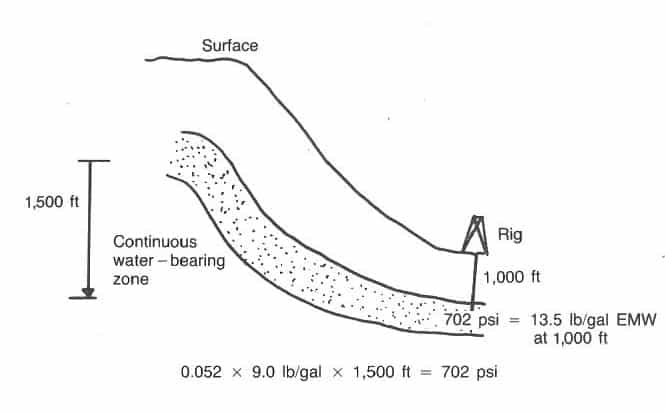
An artesian water system can create abnormal pore pressure if the proper structural conditions exist. As shown in Fig. 5, the continuous water-bearing sand will transmit hydrostatic pressures of the formation water to the bottom of the structure. The pressure at the top of the structure will be normal for the depth at which it is encountered. The pressure at the bottom of the structure will be equivalent to 13.5 Ib/gal mud weight. These pressures can not be detected with conventional techniques.
Uplift Effect On Abnormal Pore Pressure
Normal pressure is defined as the depth at which it is encountered. A normal pressure for a specific depth would be abnormally high for its shallower depth. Tectonic actions that uplift sections of formations can cause abnormal pressures in the uplifted section if specific formations within the uplifted section are sealed so the abnormal pressures cannot revert to normal during geologic time. Drilling through a fault and entering a different pressure environment is uncommon. Caution must be exercised concerning well planning because pressures across a fault line can be lower and higher than those on the opposite side of the fault.
Fig. 6 illustrates the concept of abnormal pore pressures generated by uplifting. A 12.0-lb/gal mud will be required to drill the interval at 6,000 ft.
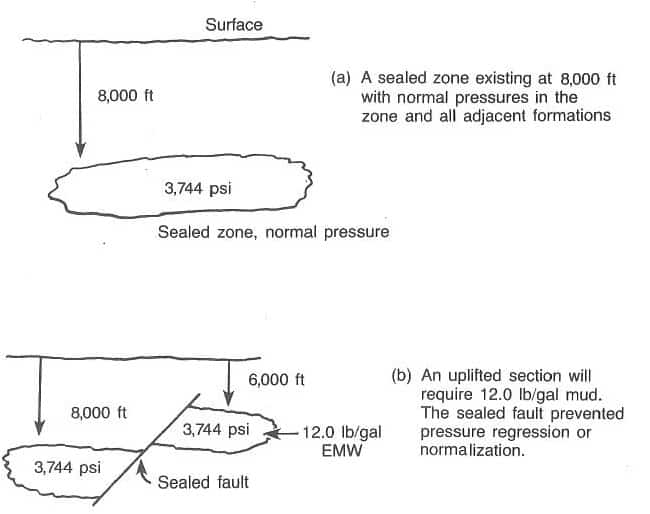
The sealed fault line. prevented a pressure regression to a normal environment.
Salt Beds.
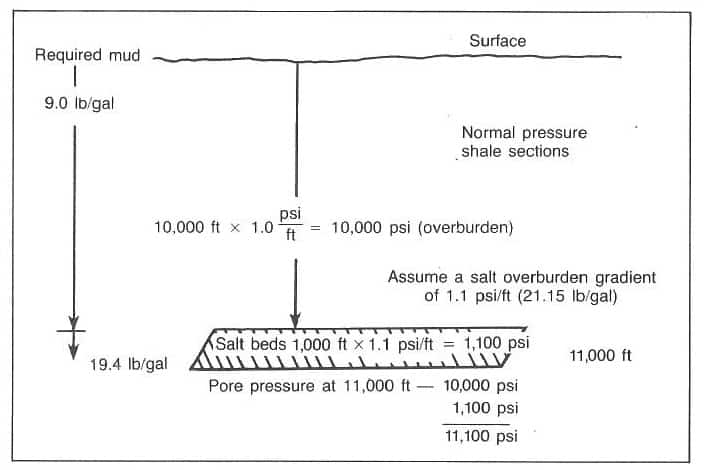
Salt beds are perhaps the dominant cause of formation pressures approaching the total overburden stress worldwide (abnormal pore pressure). Bedded salt is unique compared to shale; it is impermeable, whereas shale is semipermeable. In addition, it behaves plastically, transmitting the complete overburden stress to the underlying formations. As shown in Fig. 7, the formations below the salt beds will require mud weights in excess of 19.0 Ib/gal.
Salt Diapirism (Salt Domes) & Abnormal Pore Pressure
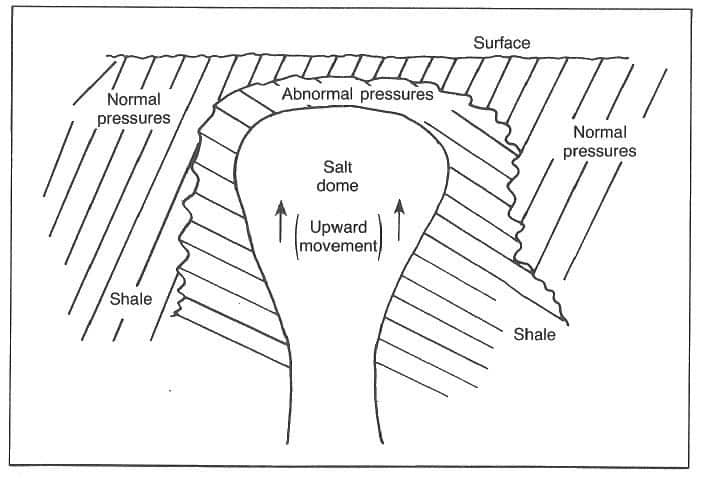
Salt diapirs, known as salt domes, result from a density inversion with a material of low shear strength. The plastic nature of the salt allows it to “flow” upward. This movement can over-compact formations in shallow sections, as shown in Fig. 8. This form of pressure generation creates unusually high formation pressures in shallow formations.
Density Differences.
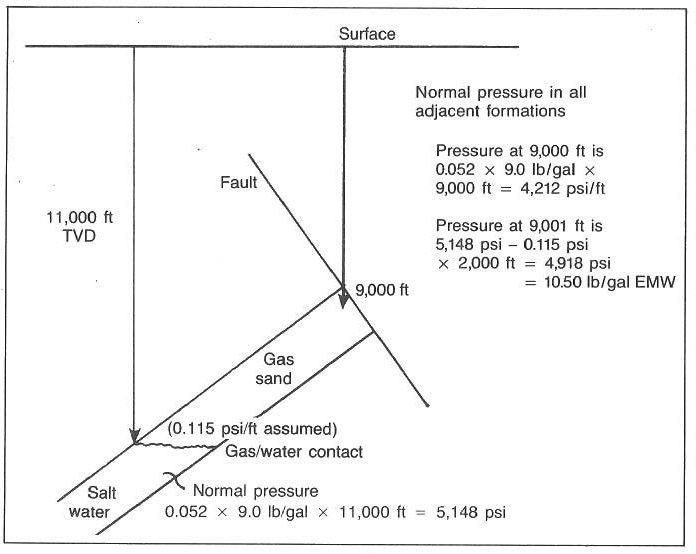
Fluid density differences between zones with connecting permeability can cause abnormal pressures. The U-tube principle is the underlying basis for this. As shown in Fig. 9, a non-horizontal zone containing a low-density fluid requires greater-than-normal mud weights to drill the upper sections of the zone. Typical requirements for this occurrence are zones with sealing mechanisms at the upper end and no permeability restrictions at the lower end.
Osmosis Effect On Abnormal Pore Pressure
Two reservoirs separated by an impermeable membrane may develop a pressure differential across the membrane as a function of a difference in the salinity of the formation liquid. Clay may act as a membrane, and because salinity changes occur in the subsurface, osmosis could create abnormal pressures. Tests have proved that a pressure differential of 21 to 28 kPa (or 3 to 4 psi) could be generated by osmosis across a clay membrane.
Hydrocarbon Bearing Formations
The permeability of shale to hydrocarbons is extremely low and can be considered zero. The system is closed at the top once hydrocarbons are trapped below a sealing shale. Figure 10 shows the basic principle.

As the aquifer is open to the base, the water-bearing part of the reservoir will be hydrostatically pressurized.
Although a normal hydrostatic pressure may exist at the hydrocarbon-water contact, the column of low-density oil, condensate, or gas on top will result in pore pressures above hydrostatic. The difference between the pore pressure and the hydrostatic pressure increases with distance from the Oil-Water Contact (OWC) or Gas-Water Contact (GWC), with the highest over-pressure at the top of the reservoir (see Figure 2.3.4). This abnormal pressure from water displacement by less dense fluids or gas is called genetic pressure.
Often, there is a slight pressure difference at the OWC as oil is pushed down through the pore throats, replacing the formation water. This pressure difference can be substantial if pore throats are small (e.g., in chalk). The pressure results from the gradient required to produce flow and work against the capillary effect.